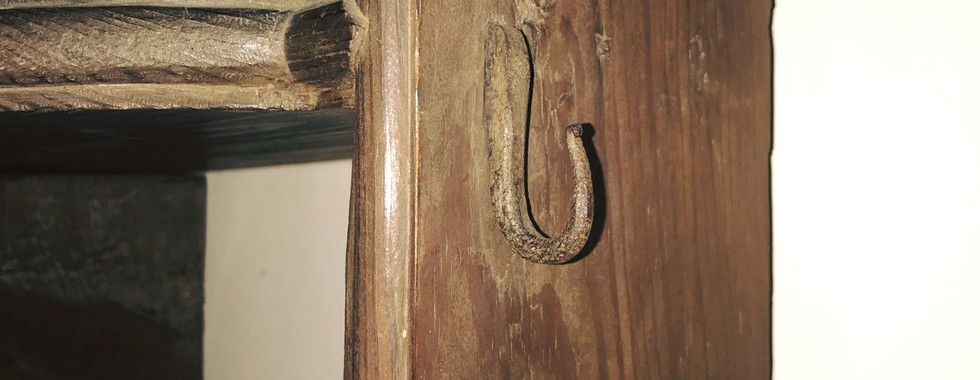Pegs, Hooks, and Shelves: Evidence of Life in the Garret

A Garret is a "top-floor or attic room, especially a small dismal one." Indeed, only a "Servants Bed," a mattress or pallet used directly on the floor valued at 1 pound ten shillings, furnished the "Middle Room" under the roof at Stenton in 1752. The listing of only a bed on the James Logan estate inventory suggests that Stenton's enslaved workers did little more than undress, sleep, and re-dress for the next day in the top of the house. Their time was entirely spent at work in service to the Logan family downstairs. Unpainted woodwork, a single window, lack of storage for personal items, and no fireplace for heat or light made for an inherently dismal and uncomfortable life in the Middle Garret. The numbers of enslaved people relegated to this middle room likely fluctuated over time. A clothes cupboard in the hall just outside the room, with eight pegs for hanging clothes, offers a sense for the numbers of enslaved people who may have occupied the unheated garret spaces.
Image above: The Middle Garret is under the roof at the front of the house. One can enter this space from the stair-hall side of the attic or the service-stair side of the attic, making it possible for those called from slumbering in this space to serve downstairs in the night without disturbing spaces downstairs unnecessarily. Notice the single dormer window and unpainted woodwork. You can see Stenton’s current Dinah exhibition and timeline related to her life, Quakers and Slavery in Pennsylvania, and the evolution of her story on the walls here. For more about Dinah, please visit www.stenton.org/Dinah
Image Captions: 1) Turned pegs in the cupboard outside the Middle Room on the service-stair side of the hall. The group of pegs to the right may have been added a bit later suggesting that the number of people using the closet may have increased. 2) The service-stair side of the garret hall, with wide, oxidized boards, pine for the walls and door panels; door framing is oak. Sound would have carried between the board walls without any plaster as insulation. 3) The bookshelf ghost in the Middle Room. Likely around the time Dinah came to labor at Stenton in service to William and Hannah Logan, after James Logan died in 1751, this leftover bookcase came to the third floor to offer the enslaved additional storage space. Designed to be supported by the chair rail and baseboard in the Blue Lodging Room downstairs, bookcase would have been rickety against the board wall. The wrought iron hook in the shelf and those in the wall may have offered tethered support as well as additional hanging space for clothes and headwear. 4) Wrought iron hook on bookshelf. 5) One of the corresponding hooks on the wall. 6) Detail of the turned pegs in the clothes closet — physical evidence of the everyday lives of the Stenton workforce.
































Phantom is a self-custodial cryptocurrency wallet designed to facilitate seamless interaction with decentralized applications (dApps) across multiple blockchain networks, including Solana, Ethereum, and Bitcoin. As a browser extension, it integrates directly into your Chrome browser, enabling users to manage their crypto assets and NFTs without the need for a separate application.
Phantom Chrome Extension | Phantom Wallet Chrome
The MetaMask Wallet Extension and HashPack Wallet are secure, user-friendly digital wallets for interacting with decentralized applications (dApps) and managing cryptocurrencies. MetaMask supports Ethereum-based assets and Web3 platforms via browser extensions, while HashPack focuses on the Hedera network, offering HBAR management and NFT support. Metamask Extension | Hashpack Wallet
Click here provide members with discounts on over-the-counter medications, vitamins, and health essentials, promoting better health management and cost-effective wellness solutions. kaiserotcbenefits.com - more details here
Click here help you find recent death notices, providing information about funeral services, memorials, and tributes for loved ones in your area. obituariesnearme.com - more details here
Click here? Many users have had mixed experiences with the platform, so it's important to read reviews and verify deals before booking. istravelurolegit.com - more details here
AV在线看 AV在线看;
自拍流出 自拍流出;
国产视频 国产视频;
日本无码 日本无码;
动漫肉番 动漫肉番;
吃瓜专区 吃瓜专区;
SM调教 SM调教;
ASMR ASMR;
国产探花 国产探花;
强奸乱伦 强奸乱伦;
The men's biker brown jacket is a timeless wardrobe essential that combines style and functionality. Crafted from high-quality leather, this jacket exudes a rugged charm while providing warmth and durability. Ideal for motorcycle enthusiasts or casual outings, the men's biker brown jacket enhances any outfit, making it a versatile choice for all occasions.